The Best Perch Rigs For Ice Fishing (Top 5 Setups)
UPDATED 18 MAY 2023
by Robert Ceran
Catching perch through the ice is incredibly fun, especially when you key in on a big school of perch that are actively feeding.
In situations like that, you’ll find yourself getting bites as soon as you lower down your rig through the ice, and end up going home with a full bucket after just a few hours.
However, perch are not always that easy to catch.
In some cases you may have to try different approaches, including switching to live bait, trying various lure and bait combinations, and testing different presentations until you find what they like.
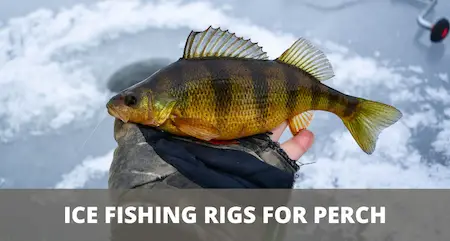
In order to help you with this, we’ll walk you through the best perch rigs for ice fishing in this article, how to set them up, and how to use them to put more perch on the ice.
What is the best ice fishing perch rig?
The 5 best ice fishing rigs for perch are:
- Tungsten jig tipped with bait
- Slip bobber rig
- Dropper rig
- Perch pounder rig
- Perch fly rig
Each of these perch rigs comes with its own set of strengths and weaknesses.
We’ll cover the full details of each of them below, and we’ll also discuss what they are ideally suited for, so you can choose the best one for your purposes.
Tungsten jig tipped with bait
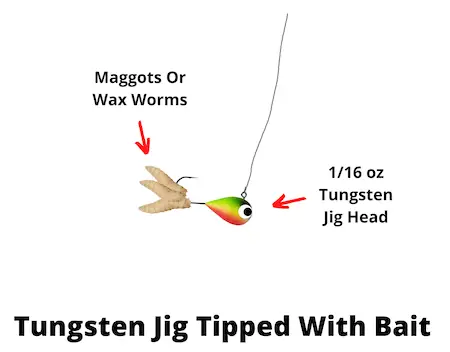
A tungsten jig tipped with bait is the simplest ice fishing rig for perch, but at the same time highly effective and versatile, and so should always be in your tackle box.
How to tie it: If you’re using monofilament or fluorocarbon as your main line, all you need to do is tie your main fishing line directly to a tungsten jig head, and then bait the hook of the jig with spikes, waxies, or a perch eyeball, and you’re good to go.
It’s always a good idea to experiment with different colors and sizes, to see what works best for you.
How to use it: While you can use this rig on a deadstick and wait for a perch to take the bait, by far the best method is to fish it actively.
Work on finding a jigging cadence that triggers the perch to bite, which can be easy when they’re feeding actively, but challenging when they’re not.
When to use it: This is my go-to rig when I start ice fishing in a new lake and don’t know what the perch are keyed in on.
I’ll use it together with a fish finder to see if they start marking my jig, and then I’ll try to see if I can trigger bites.
I also use it in combination with a live bait rig fished on a deadstick rod on a second ice hole.
Slip bobber rig for perch ice fishing
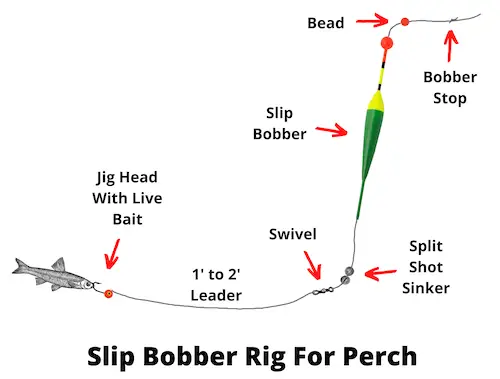
The slip bobber rig is probably the most versatile fishing rig for all freshwater fishing, and it also comes in extremely handy as one of the best live bait rigs for perch ice fishing.
How to tie it: Start by threading your main line through a bobber stopper, followed by a plastic bead and then your slip bobber.
In general it’s best to choose a relatively thin finesse bobber, as yellow perch don’t respond well to resistance when they try to take the bait.
After threading the bobber onto the line, add a split shot weight or two below the bobber, and then tie on a swivel.
Next, tie a 1 to 2 foot leader to the swivel, and tie a 1/16 oz jig head to the other end of the leader. I like to use a 6 lb test fluorocarbon as my leader.
The jig head is important in order to keep your minnow close to the bottom.
How to use it: Set the depth of the slip bobber so that your hook is about 6 to 12 inches above the bottom, bait the hook with a 2 to 3 inch live minnow, and then lower the rig into one of your ice holes.
While you wait for the bobber to go down, it’s a good idea to jig actively on a second ice hole, since that helps to attract perch to come and investigate.
When to use it: While the slip bobber rig is also a great all-around rig for perch ice fishing, it performs best when the perch are finicky and don’t bite your jig or spoon.
When that happens, you’ll often see them on your fish finder, marking your lure, but not committing to it. On days like that, you’ll probably get most bites on the slip bobber rig.
Dropper rig for perch ice fishing
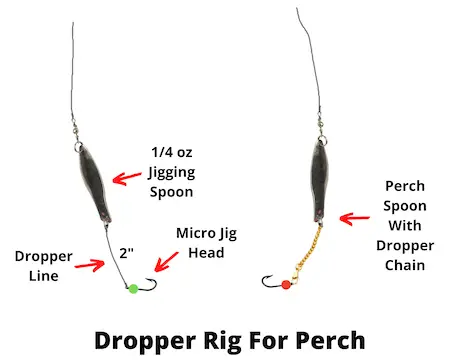
This setup is one of the most effective perch ice fishing rigs, and combines the strengths of a large flashy spoon with a finesse hook rigged below it.
How to tie it: If you want to tie this yourself, remove the treble hook from a 1/4 oz jigging spoon, and then tie on a 2 to 2.5 inch dropper line with a micro jig head (1/32 oz) at the end of it.
The dropper line should not be longer than two and a half inches, since that reduces effectiveness. Next, tip the hook with wax worms, maggots, or a perch eyeball, and you’re good to go.
An easier option to tying the dropper rig yourself is to buy perch spoons that come with a dropper chain already rigged on, and are ready to go out of the box (as shown on the right hand side in the image above).
My favorite are the Hali lures, which are probably the most effective ice fishing lures for perch ever made.
How to use it: Fish this just as you would a tungsten jig, by jigging it close to the bottom, and observing the reaction of the perch on your fish finder or flasher (such as a Marcum or Vexilar). Experiment with your jigging cadence to find what triggers bites.
When to use it: The dropper rig is great when ice fishing for perch in shallow to medium depth water, and is my go-to option when I don’t get bites on a traditional jig or spoon.
Essentially, this setup combines the strength of a big, flashy spoon (which serves to call in perch to investigate), with a finesse hook and bait rigged just below it (which seals the deal and triggers bites).
Perch pounder rig for ice fishing
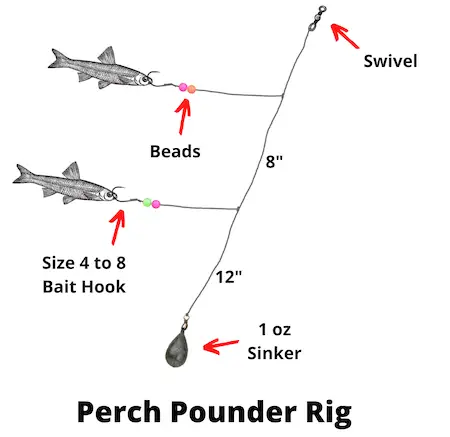
The perch pounder rig is also known as the double minnow rig, and was originally developed by great lakes anglers targeting big perch in deep water.
How to tie it: The whole rig is tied with one piece of leader line, which needs to be heavy enough to make it relatively stiff (in order to avoid the baited hooks getting tangled with the main line).
You can use either monofilament or fluorocarbon, but my preferred choice is 15 to 20 lb test fluoro, which is quite stiff, but still has low visibility in the water.
Start by tying a loop in the leader line, by forming a loop, folding it back on itself, and doing 3 overhand knots.
Once formed, cut one of the arms of the loop, which results in a single line sticking out from the main line. Then thread 1 or 2 colored beads onto the line, and tie on a size 4 to 8 bait keeper hook.
When done with the first hook, tie a second loop in the same way, about 8 inches below the first, and attach the beads and hook to it.
About 12 inches below the lower hook, cut off the leader line and tie on a 1 oz sinker (or use a clip-on drop shot sinker).
Finally, cut off the leader above the top hook, and tie on a swivel, which you can use to attach your main line.
How to use it: Bait the hooks with live minnows, and then lower it to the bottom and wait for bites.
If you use big minnows (2 to 3 inches long), you can specifically target big jumbo perch, since the smaller ones shy away from bait fish this big.
As with all perch ice fishing rigs, it’s best to use a fish finder to check if there are any perch in the area, and also to monitor how they react to your rig.
When to use it: This is a great rig to use in deep water of 40 or 50 feet, and so is most useful in mid-winter, when perch retreat to deeper water, where they form huge schools that sometimes have more than a thousand fish.
In order to find one of these schools, you may have to drill a series of ice fishing holes, and use the help of a lake map and a fish finder.
Perch fly rig for ice fishing
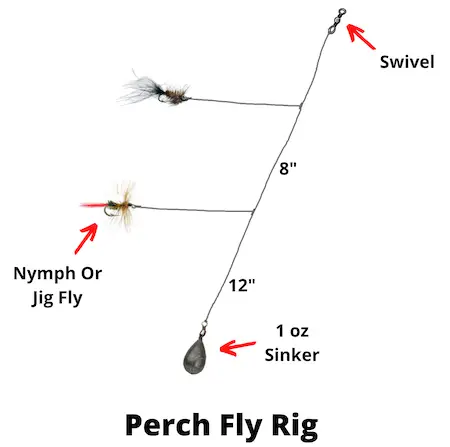
The fly rig is essentially a finesse version of the pounder rig, and can be used when targeting perch in shallow to mid-depth water.
How to tie it: Tie it just as you would tie the perch pounder rig (see above), but instead of hooks, tie on nymphs or jig flies.
It’s important to use a relatively heavy line (I like 15 lb test fluoro), since that prevents the ‘arms’ from getting tangled with the main line.
You can also use spreaders for the same purpose (which are metal arms sticking out from the main line), but this makes the rig a lot more clunky and heavy.
How to use it: Drill a series of holes over mud and weed flats, and then lower down your rig and twitch your perch ice rod tip in subtle movements to impart movement to the flies (but without actually lifting the weight from the bottom).
You may also want to use a spring bobber tip to help you detect subtle bites.
When to use it: The perch fly rig is an excellent option when ice fishing for suspended perch over weed beds.
By using a clip-on drop shot weight, you can easily adjust the depth at which your flies are presented above the weeds, and thus key in on the right depth.
Tip up rig for perch
While tip ups are most often used to target bigger fish (such as northern pike and walleye) with ice fishing, most people don’t know that you can also use a finesse tip up for perch ice fishing.
In order to get started, refer to our guide on how to ice fish with tip ups to get the basic idea.
When rigging a tip up for yellow perch, it’s best to use a relatively light Dacron braided line around 15 to 20 lb test.
Next, tie on a 6 to 8 lb test fluorocarbon leader that’s about 2 to 3 foot long, and then tie a size 4 to 8 hook to the end of the leader.
Add a few split shot weights about a foot above the hook, and then bait the hook with a live minnow, waxworms, or spikes.
Next, lower the baited tip up rig down through the ice hole, cock the flag mechanism, and you’re ready to start ice fishing.
And lastly, always make sure that your bait is presented close to the bottom.
Final remarks
This concludes our article on how to rig for perch ice fishing.
I hope you found one or more rigs that are useful for you, and will help you to put more fish on the ice.
In general, if perch are feeding actively, you can use pretty much any rig and will get plenty of bites, and may easily end up catching hundreds of fish.
However, if perch aren’t in a feeding mood (and especially if they are pressured), it’s often helpful to switch up your strategy, and experiment with different rigs, baits, and presentations.
Hopefully this is when you can get an edge by using some of the setups discussed here.
